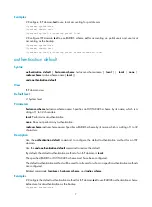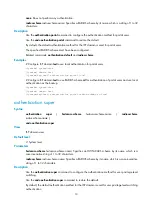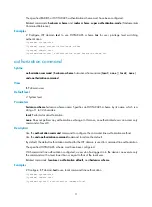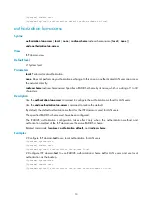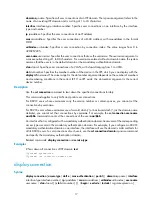
7
Examples
# Configure ISP domain
test
to use local accounting for portal users.
<Sysname> system-view
[Sysname] domain test
[Sysname-isp-test] accounting portal local
# Configure ISP domain
test
to use RADIUS scheme
rd
for accounting on portal users and use local
accounting as the backup.
<Sysname> system-view
[Sysname] domain test
[Sysname-isp-test] accounting portal radius-scheme rd local
authentication default
Syntax
authentication default
{
hwtacacs-scheme
hwtacacs-scheme-name
[
local
] |
local
|
none
|
radius-scheme
radius-scheme-name
[
local
] }
undo authentication default
View
ISP domain view
Default level
2: System level
Parameters
hwtacacs-scheme
hwtacacs-scheme-name
: Specifies an HWTACACS scheme by its name, which is a
string of 1 to 32 characters.
local
: Performs local authentication.
none
: Does not perform any authentication.
radius-scheme
radius-scheme-name
: Specifies a RADIUS scheme by its name, which is a string of 1 to 32
characters.
Description
Use the
authentication default
command to configure the default authentication method for an ISP
domain.
Use the
undo authentication default
command to restore the default.
By default, the default authentication method of an ISP domain is
local
.
The specified RADIUS or HWTACACS scheme must have been configured.
The default authentication method will be used for all users for whom no specific authentication methods
are configured.
Related commands:
local-user
,
hwtacacs scheme
, and
radius scheme
.
Examples
# Configure the default authentication method for ISP domain
test
to use RADIUS authentication scheme
rd
and use local authentication as the backup.
<Sysname> system-view















